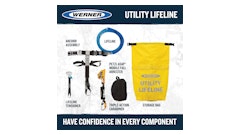
Editor's Note: This is the second entry of a series relating to lived experience with opioid addiction treatment and recovery, providing naloxone in the workplace and on jobsites, as well as resources for grief and bereavement. Find links to the series here.
In the summer of 2022, while working for DPR Construction Scott Kubiszewski was spearheading an initiative to consider stocking naloxone on all the company’s jobsites in the Pacific Northwest. Kubiszewski was growing increasingly aware of the rising rate of both fatal and non-fatal overdoses attributable to opioids. Kubiszewski was knowledgeable about the benefits of stocking naloxone in the workplace to help reduce the risk of overdose for opioids. Naloxone (also known as Narcan) is a medication that reverses the effects of opioids and is used to help save lives by administering it to persons experiencing signs and symptoms of overdose.
Unfortunately, Kubiszewski and other safety/health practitioners were receiving pushback and resistance from other industry professionals about potential legal and risk management concerns about stocking naloxone in the workplace. He reached out to me for guidance; we previously collaborated on workplace suicide prevention initiatives. I provided resources to Kubiszewski regarding state-by-state laws for both naloxone access and Good Samaritan provisions. I also advised that the US Food and Drug Administration (FDA) was considering approving naloxone for over-the-counter use, but that approval was not expected until 2023.
Naloxone as the New AED for Workplaces
Kubiszewski secured support from DPR Construction to move forward with stocking naloxone on the company’s jobsites in the Pacific Northwest. He often cites how early adopters were quickly viewing naloxone as the new AED on jobsites. AEDs are automated external defibrillators used to revive persons in cardiac arrest. Kubiszewski recounted the rapid adoption of AEDs in workplaces and on jobsites once the initial resistance was overcome. “A dozen years ago, AEDs were rare on jobsites and today they are commonplace,” exclaimed Kubiszewski. He imagined “how many lives might be saved if naloxone were available in first aid kits throughout the construction industry.”
Watch this video on using Naloxone to reverse opioid overdose, by the National Association of Home Builders.
Forming the Alliance for Naloxone Safety in the Workplace
By the fall of 2022, Kubiszewski expressed a desire to form an industry workgroup to further collaborate on developing starter resources for companies interested in stocking naloxone in company workplaces and jobsites. He asked Beyer for guidance since his efforts years earlier led to the formation of the Construction Industry Alliance for Suicide Prevention. Beyer offered to help Kubiszewski identify a group of like-minded national safety/health and wellbeing leaders from various disciplines to brainstorm the needs of the industry to help expand the adoption of naloxone on jobsites. Twenty-three (23) founding members of the Alliance for Naloxone Safety in the Workplace (ANSW) agreed to collaborate. A list of all founding member organizations is prominently posted on the ANSW website.
Kubiszewski said, “The group quickly morphed to an active team comprised of various construction industry stakeholders, including contractors/employers, labor unions, trade associations, mental health advocates, population health and employee benefit service providers, and other industry professionals.” The group instituted working subcommittees with assigned chairpersons and accountability standards for updating the group on action steps taken since the most recent prior biweekly meeting. Kubiszewski shared how alliance leaders “worked diligently and with urgency.” He stated the group was “aware of the desperate need to reduce potentially preventable overdoses by educating and equipping all industry stakeholders on the benefits of providing naloxone in the workplace and on jobsites.”
The much-anticipated FDA approval of naloxone in March 2023 for over-the-counter sales helped “grease the skids” for the ANSW. Demand for informational resources, policy guidance, and training support relating to naloxone across all industries has grown exponentially. Various nonprofit organizations have been ramping up resources to support employers seeking to become trained on using naloxone in the workplace. According to Jeff Horwitz, CEO of the national nonprofit SAFE Project, “This is great news because it not only provides us with an opportunity to help employers protect their workforce today from overdoses, but it also allows us to discuss little-known alternatives to opioids as well as first dose prevention techniques to manage pain to better protect their employees and family members in the future.”
Stigma as the Major Barrier
A guiding principle of the ANSW leaders was to help employers in all industries overcome common obstacles in considering stocking naloxone in workplaces and jobsites. The group wanted to expand awareness of the risks posed by opioids and increase the adoption by employers of naloxone in workplaces. The group identified the biggest obstacle to overcome is the stigma and judgement associated with substance misuse and overdose prevention. Stigma creates a barrier that limits workers and their family members from seeking access to treatment and recovery programs. Stigma also commonly restricts some employers and labor organizations from discussing addiction and taking measures to educate employees and families about treatment options.
Launching the ANSW Website
The founding members of ANSW focused on the development of shared resources that would be freely shared online. The website launched in November 2023 with a detailed set of Frequently Asked Questions (FAQs). The website provides access to a downloadable sample policy with standard procedures. Founding member MindForge produced a standardized training video that can be downloaded for free as well.
Kubiszewski said he is both “happy and humbled to have taken part in such an impactful industry initiative”. He expresses “respect and admiration for the fellow founding members of the ANSW for their commitment of passion, time, and energy to this volunteer project.” Kubiszewski is pleased that ANSW.org is “receiving positive feedback throughout the industry both in the US and internationally.” He “is excited by the number of postings being shared about the ANSW website on LinkedIn and other social media channels.”
Coauthor Beyer is proud of Kubiszewski’s selfless leadership in envisioning such a bold industry initiative. The ANSW is quickly spreading across the industry to reduce the risk of opioids and prevent overdose deaths. This expanding social movement has the potential to save lives by educating millions of construction stakeholders on opioid risk reduction. Kudos to the founding members of the ANSW for the collective leadership in driving a necessary industry innovation.





























